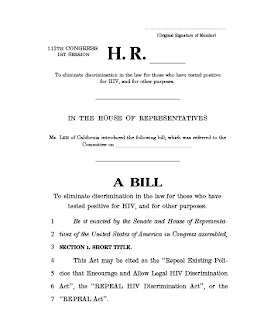Press Release
New York, September 23, 2011 – Members of the Positive Justice Project, a national coalition dedicated to ending the targeting of people with HIV for unreasonable criminal prosecution, voiced their support for the REPEAL HIV Discrimination Act that Congresswoman Barbara Lee (D-CA) introduced today.
 |
| Download the REPEAL ACT here |
The bill calls for review of all federal and state laws, policies, and regulations regarding the criminal prosecution of individuals for HIV-related offenses. It is the first piece of federal legislation to take on the issue of HIV criminalization, and provides incentives for states to reconsider laws and practices that unfairly target people with HIV for consensual sex and conduct that poses no real risk of HIV transmission.
The proposed bill is being met with widespread support. Ronald Johnson, Vice President for Policy and Advocacy at AIDS United (a Positive Justice Project member) says, “AIDS United supports the REPEAL HIV Discrimination Act. It’s long past time for a review of these criminal and civil commitment laws and we welcome Representative Barbara Lee’s efforts to help local and state officials understand and make needed reforms.”
Thirty-four states and two U.S. territories now have laws that make exposure or non-disclosure of HIV a crime. Sentences imposed on people convicted of HIV-specific offenses can range from 10-30 years and may include sex offender registration even in the absence of intent to transmit HIV or actual transmission. Though condom use significantly reduces the risk of HIV transmission, most HIV-specific laws do not consider condom use a mitigating factor or as evidence that the person did not intend to transmit HIV.
For example, a man with HIV in Iowa received a 25-year sentence for a one-time sexual encounter during which he used a condom and HIV was not transmitted; although the sentence was eventually suspended, he still was required to register as a sex offender and is barred from unsupervised contact with children. People also have been convicted for acts that cannot transmit HIV, such as a man with HIV in Texas who currently is serving 35 years for spitting at a police officer.
“The Repeal HIV Discrimination Act relies on science and public health, rather than punishment, as the lead response to HIV exposure and transmission incidents. It embodies the courage and leadership needed to replace expensive, pointless and punitive reactions to the complex challenge of HIV with approaches that can truly reduce transmission and stigma,” remarked Catherine Hanssens, Executive Director of the Center for HIV Law and Policy and a founder of the Positive Justice Project
Representative Lee’s bill requires designated officials to develop a set of best practices, and accompanying guidance, for states to address the treatment of HIV in criminal and civil commitment cases. The bill also will provide financial support to states that undertake education, reform and implementation efforts. A fact sheet created by The Center for HIV Law and Policy, AIDS United, Lambda Legal and the ACLU AIDS Project summarizes the problems with HIV criminalization and the measures the REPEAL HIV Discrimination Act takes to address them.
“The REPEAL HIV Discrimination Act will serve a critical role in educating Members of Congress and the public about the harmful and discriminatory practice of criminalizing HIV. Such state laws often originated during times when fear and ignorance over HIV transmission were widespread, and serve to stigmatize those who are living with HIV. Our criminal laws should not be rooted in outdated myths. Rep. Lee is to be commended for her tireless leadership on behalf of those who are living with HIV/AIDS,” said Laura W. Murphy, director of the ACLU Washington Legislative Office.
Scott Schoettes, HIV Project Director at Lambda Legal summarized the support of many. “Lambda Legal wholeheartedly supports the ‘REPEAL HIV Discrimination Act.’ It is high time the nation’s HIV criminalization laws were reformed to reflect the modern reality of living with HIV, both from medical and social perspectives. Except for perhaps the most extreme cases, the criminal law is far too blunt an instrument to address the subtle dynamics of HIV disclosure.”
Other PJP member statements in support of the REPEAL HIV Discrimination Act:
“The HIV Prevention Justice Alliance expresses our strong commitment to HIV decriminalization and ongoing support for Representative Barbara Lee’s Repeal HIV Discrimination Bill. We have seen how the criminalization of HIV has increased instead of reduced HIV stigma and panic. We have also seen how the criminalization of HIV further targets communities – black, Latino/a, queer, transgender, low income, sex worker, homeless, drug user – which are already disproportionately impacted by HIV/AIDS and mass incarceration. We applaud Congresswoman Lee’s courageous effort to support resiliency and dignity of HIV positive people and loved ones and affirm her continued support for prevention justice and decriminalization.”
—Che Gossett, Steering Committee Member, HIV Prevention Justice Alliance
“This is definitive legislation in the national fight to end HIV discrimination and for survivors of criminalization.”
—Robert Suttle, Member of Louisiana AIDS Advocacy Network (LAAN)
“A Brave New Day is in full support of Rep. Barbara Lee’s Anti-Criminalization bill.”
—Robin Webb, Executive Director of A Brave New Day
“We feel strongly that many such statutes violate human rights, are constitutionally vague, are irrational, and violate the laws of science in that they attempt to characterize known scientifically proven facts about transmission as irrelevant to the issue of potential damage and danger. We feel that people’s ‘fear’ if irrational cannot provide a basis for a criminal statute or prosecution under same and that a statute cannot be both legal and illogical.”
—David Scondras, Founder/CEO, Search For A Cure
For a list of organizations supporting the REPEAL HIV Discrimination Act, click here.


